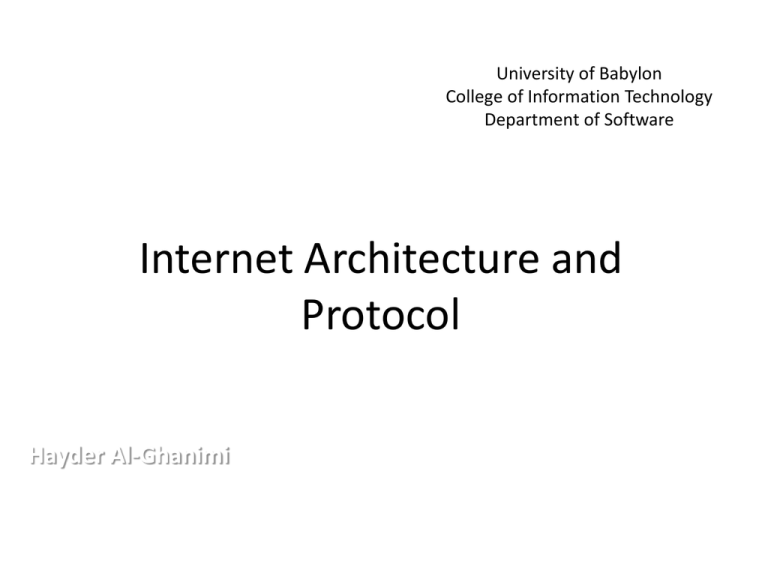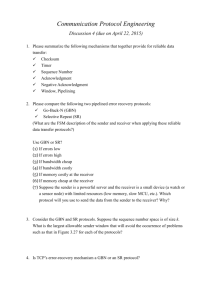Internet Architecture and Protocol Hayder Al-Ghanimi University of Babylon
advertisement

University of Babylon College of Information Technology Department of Software Internet Architecture and Protocol Hayder Al-Ghanimi Protocols and layering • Network protocols and software • Layered protocol suites • The OSI 7 layer model • Common network design issues and solutions What is a protocol • A protocol is an agreement on how to communicate • Includes – Syntax: how a communication is specified & structured • Format, order messages are sent and received • Semantics: what a communication means – Actions taken when transmitting, receiving, or when a timer expires – Timing: when and how long Examples of Protocols in Human Interactions • Telephone 1. (Pick up / open up the phone.) 2. Listen for a dial tone / see that you have service. 3. Dial. 4. Should hear ringing … 5. Callee: “Hello?” 6. Caller: “Hi, it’s Hayder….” Or: “Hi, it’s me” (¬ what’s that about?) 7. Caller: “Hey, do you think … blah blah blah …” pause 8. Callee: “Yeah, blah blah blah …” pause 9. Caller: Bye 10. Callee: Bye 11. Hang up Examples of Protocols in Human Interactions • Asking a question 1. Raise your hand. 2. Wait to be called on. 3. Or: wait for speaker to pause and vocalize The need for protocols • Basic communication hardware can transfer bits from one place to another • Communication software provides a convenient high level interface for application programmers – do not have to deal directly with hardware – can run over different hardware • A set of rules for exchanging messages is a network protocol Protocol suites • Rather than having a single huge protocol, protocols tend to be structured as suites of specific protocols – design and testing is easier – extension and updating is easier – selection and combination becomes possible Layering • The most common approach to designing protocol suites • Each layer deals with a different level of abstraction and communicates with the layers above and below Example - the OSI 7 layer model • • • • ISO model for standardising all networks Now 20 years old and woefully out of date Probably too complex However, still provides useful terminology and a good general example of layering The 7 OSI layers Conceptual path of data Commercially available stacks Multiple nested headers • Each layer places information in a header before passing a packet to a lower layer and removes it before passing it to an upper layer Layering principle • Layer N software on the destination computer must receive exactly the message sent by layer N software on the sending computer Common networking issues • • • • • • Sequencing for out-of-order delivery Sequencing to remove duplicate packets Re-transmitting lost packets Avoiding replay caused by excessive delay Flow control to prevent data overrun Mechanisms to avoid network congestion Sequencing for out-of-order delivery • Connectionless network with dynamic routing may deliver packets out of order • Transport protocols solve this with sequencing • Each packet is given a sequence number • The receiver notes the number of the last packet that arrived in sequence and stores additional out of order packets • The packets are delivered in sequence to the next layer up Sequencing to reject duplicates • Malfunctioning hardware can produce multiple copies of a packet • Sequence numbers allow duplicates to be detected and discarded Re-transmitting lost packets • Packet loss is a fundamental problem due to transmission errors • One approach to reliable transmission involves positive acknowledgements – sender transmits and starts a timer – receiver receives and acknowledges – on time-out the sender transmits again – the receiver must watch out for duplicates Avoiding replay caused by delay • A duplicate packet might turn up in a later session (e.g., if it was queued in a switch for a long time) • May be confused with a packet from the later session that uses the same sequence number • Solution is to include a session identifier in the packet Flow control to prevent overrun • Data overrun occurs when the sender sends faster than the receiver can receive • Simple solution is to acknowledge each packet before sending the next (“stop and go”) • However, this can be wasteful of bandwidth Sliding window protocols • Sender and receiver agree a window size (number of packets) • Initially a whole window is sent • After that, each packet is acknowledged and then another can be sent Congestion • Congestion arises due to too much traffic and/or bottlenecks in the network • Limited storage in switches means that packets get dropped Dealing with congestion • Detecting congestion – switches can inform senders – packet loss can be used as a measure of congestion OSI Model in Details This is the second part of this lecture • The model • Functions of the layers 7OSI Application Presentation This is the second part of this lecture [ 1] PHYSICAL LAYER Session Transport Network Data Link Physical Goals of Physical Layer • Service: move information between two systems connected by a physical link • Interface: specifies how to send and receive bits • Protocol: coding scheme used to represent a bit, voltage levels, duration of a bit • Examples: coaxial cable, optical fiber links; transmitters, receivers Goals of this lecture for Physical • Explain how electric current can be used to transmit bits over short distances • Present a popular mechanism (RS-232) for sending characters this way • Introduce notions of baud rate and bandwidth Asynchronous communication • Where the receiver does not know when the sender will transmit – transmit when data is ready – variable delays between transmissions – no sender-receiver coordination beforehand • E.g., keyboard connected to a computer • Technically, the electrical signal does not contain information about where individual bits begin and end Using electric current to send bits • Use a wire to create a circuit between the sender and receiver • Negative voltage on the wire could represent a 1 and positive a 0 • Waveform diagram shows variable delay The RS-232 standard • To connect keyboards, terminals etc. to computers over copper wire • Is concerned with 7-bit characters • Electrical details (voltages) • Serial communication • Asynchronous (for each character) RS-232 continued • Never leaves 0 volts on the wire - an idle line is the same as a 1 bit • Sender and receiver agree how long a bit lasts - receiver uses a local timer • A 0 start bit signifies the start of a character and is followed by 7 data bits • A minimum gap of 1 bit between characters (a phantom stop bit of 1) Example RS-232 waveform Baud rate • Transmission hardware is rated in baud - the number of signals that are generated per second • The baud rate need not be the same as the bit rate, it depends on how many levels of signal are used • With RS-232 they are the same Agreeing the Baud rate • Sender and receiver agree on length of time each bit is held => maximum number of bits per second (e.g., 300, 9600, 19200) • RS-232 may often have a configurable baud rate (manually or by software) Framing errors • Might occur if the sender and receiver are set to different baud rates • Receiver samples the signal several times for each bit to check for differences (framing errors) • Used by the break key to send an abort signal Full duplex communication • Two wires required to carry information in one direction (return is a ground) • Full duplex is two way communication and needs 3 wires - ground is shared Hardware bandwidth • Hardware cannot change signals instantly => maximum speed at which bits can be sent • Bandwidth - maximum frequency of signal that a transmission medium can carry • Measured in cycles per sec = Hertz (Hz) • Every system (electronic and biological) has a limited bandwidth Bitrate, Baudrate and Bandwidth • Bitrate – how many bits per second are being sent • Baudrate – how many signals per second are used to send those bits • Bandwidth – the number of signals per second that a medium can accommodate









